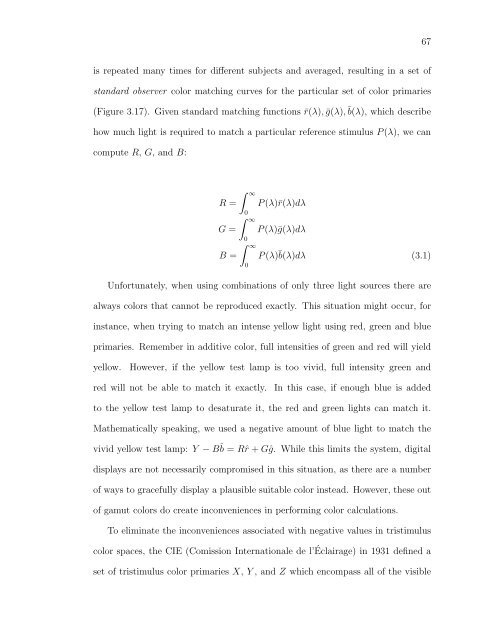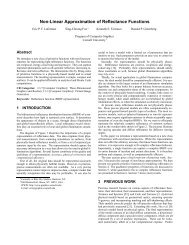pigmented colorants: dependence on media and time - Cornell ...
pigmented colorants: dependence on media and time - Cornell ...
pigmented colorants: dependence on media and time - Cornell ...
Create successful ePaper yourself
Turn your PDF publications into a flip-book with our unique Google optimized e-Paper software.
is repeated many <strong>time</strong>s for different subjects <strong>and</strong> averaged, resulting in a set of<br />
st<strong>and</strong>ard observer color matching curves for the particular set of color primaries<br />
(Figure 3.17). Given st<strong>and</strong>ard matching functi<strong>on</strong>s ¯r(λ), ¯g(λ), ¯ b(λ), which describe<br />
how much light is required to match a particular reference stimulus P (λ), we can<br />
compute R, G, <strong>and</strong>B:<br />
R =<br />
G =<br />
B =<br />
∞<br />
0<br />
∞<br />
0<br />
∞<br />
0<br />
P (λ)¯r(λ)dλ<br />
P (λ)¯g(λ)dλ<br />
67<br />
P (λ) ¯ b(λ)dλ (3.1)<br />
Unfortunately, when using combinati<strong>on</strong>s of <strong>on</strong>ly three light sources there are<br />
always colors that cannot be reproduced exactly. This situati<strong>on</strong> might occur, for<br />
instance, when trying to match an intense yellow light using red, green <strong>and</strong> blue<br />
primaries. Remember in additive color, full intensities of green <strong>and</strong> red will yield<br />
yellow. However, if the yellow test lamp is too vivid, full intensity green <strong>and</strong><br />
red will not be able to match it exactly. In this case, if enough blue is added<br />
to the yellow test lamp to desaturate it, the red <strong>and</strong> green lights can match it.<br />
Mathematically speaking, we used a negative amount of blue light to match the<br />
vivid yellow test lamp: Y − B ˆ b = Rˆr + Gˆg. While this limits the system, digital<br />
displays are not necessarily compromised in this situati<strong>on</strong>, as there are a number<br />
of ways to gracefully display a plausible suitable color instead. However, these out<br />
of gamut colors do create inc<strong>on</strong>veniences in performing color calculati<strong>on</strong>s.<br />
To eliminate the inc<strong>on</strong>veniences associated with negative values in tristimulus<br />
color spaces, the CIE (Comissi<strong>on</strong> Internati<strong>on</strong>ale de l’ Éclairage) in 1931 defined a<br />
set of tristimulus color primaries X, Y ,<strong>and</strong>Z which encompass all of the visible



